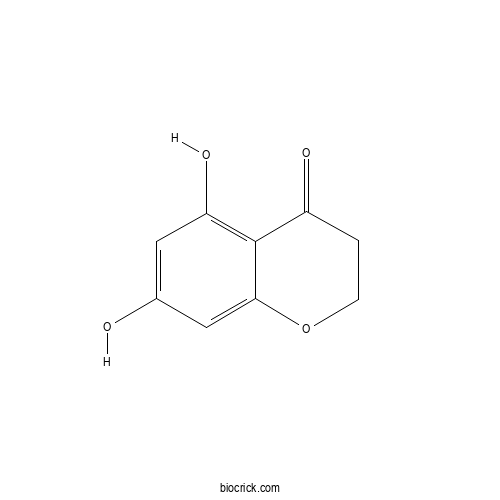5,7-Dihydroxychroman-4-oneCAS# 108085-46-7 |

Quality Control & MSDS
3D structure
Package In Stock
Number of papers citing our products

| Cas No. | 108085-46-7 | SDF | Download SDF |
| PubChem ID | 25094514.0 | Appearance | Powder |
| Formula | C9H8O4 | M.Wt | 180.16 |
| Type of Compound | Dihydroflavones | Storage | Desiccate at -20°C |
| Solubility | Soluble in Chloroform,Dichloromethane,Ethyl Acetate,DMSO,Acetone,etc. | ||
| Chemical Name | 5,7-dihydroxy-2,3-dihydrochromen-4-one | ||
| SMILES | C1COC2=CC(=CC(=C2C1=O)O)O | ||
| Standard InChIKey | NDDUBDUPYJZIAK-UHFFFAOYSA-N | ||
| Standard InChI | InChI=1S/C9H8O4/c10-5-3-7(12)9-6(11)1-2-13-8(9)4-5/h3-4,10,12H,1-2H2 | ||
| General tips | For obtaining a higher solubility , please warm the tube at 37 ℃ and shake it in the ultrasonic bath for a while.Stock solution can be stored below -20℃ for several months. We recommend that you prepare and use the solution on the same day. However, if the test schedule requires, the stock solutions can be prepared in advance, and the stock solution must be sealed and stored below -20℃. In general, the stock solution can be kept for several months. Before use, we recommend that you leave the vial at room temperature for at least an hour before opening it. |
||
| About Packaging | 1. The packaging of the product may be reversed during transportation, cause the high purity compounds to adhere to the neck or cap of the vial.Take the vail out of its packaging and shake gently until the compounds fall to the bottom of the vial. 2. For liquid products, please centrifuge at 500xg to gather the liquid to the bottom of the vial. 3. Try to avoid loss or contamination during the experiment. |
||
| Shipping Condition | Packaging according to customer requirements(5mg, 10mg, 20mg and more). Ship via FedEx, DHL, UPS, EMS or other couriers with RT, or blue ice upon request. | ||

5,7-Dihydroxychroman-4-one Dilution Calculator

5,7-Dihydroxychroman-4-one Molarity Calculator
| 1 mg | 5 mg | 10 mg | 20 mg | 25 mg | |
| 1 mM | 5.5506 mL | 27.7531 mL | 55.5062 mL | 111.0124 mL | 138.7655 mL |
| 5 mM | 1.1101 mL | 5.5506 mL | 11.1012 mL | 22.2025 mL | 27.7531 mL |
| 10 mM | 0.5551 mL | 2.7753 mL | 5.5506 mL | 11.1012 mL | 13.8766 mL |
| 50 mM | 0.111 mL | 0.5551 mL | 1.1101 mL | 2.2202 mL | 2.7753 mL |
| 100 mM | 0.0555 mL | 0.2775 mL | 0.5551 mL | 1.1101 mL | 1.3877 mL |
| * Note: If you are in the process of experiment, it's necessary to make the dilution ratios of the samples. The dilution data above is only for reference. Normally, it's can get a better solubility within lower of Concentrations. | |||||

Calcutta University

University of Minnesota

University of Maryland School of Medicine

University of Illinois at Chicago

The Ohio State University

University of Zurich

Harvard University

Colorado State University

Auburn University

Yale University

Worcester Polytechnic Institute

Washington State University

Stanford University

University of Leipzig

Universidade da Beira Interior

The Institute of Cancer Research

Heidelberg University

University of Amsterdam

University of Auckland

TsingHua University

The University of Michigan

Miami University

DRURY University

Jilin University

Fudan University

Wuhan University

Sun Yat-sen University

Universite de Paris

Deemed University

Auckland University

The University of Tokyo

Korea University
- 7,3',5'-Trihydroxyflavanone
Catalog No.:BCX1222
CAS No.:847375-46-6
- 7'R,8'R-2,2'-Dimethoxy-4-(3-hydroxyl-propenyl)-4'-(1,2,3-trihydroxy-propyl) biphenyl ether
Catalog No.:BCX1221
CAS No.:515813-60-2
- 7,8,3',4'-Tetrahydroxyflavanone
Catalog No.:BCX1220
CAS No.:489-73-6
- Sinocrassoside C1
Catalog No.:BCX1219
CAS No.:909803-26-5
- Panaxcerol C
Catalog No.:BCX1218
CAS No.:63180-02-9
- Linocinnamarin
Catalog No.:BCX1217
CAS No.:554-87-0
- α-D-altro-3-Heptulofuranose
Catalog No.:BCX1216
CAS No.:25545-06-6
- Dihydrooroxylin A-7-O-β-D-glucuronide
Catalog No.:BCX1215
CAS No.:1370002-08-6
- Hydroxy-ε-sanshool
Catalog No.:BCX1214
CAS No.:252193-26-3
- Ethyl linoleate
Catalog No.:BCX1213
CAS No.:544-35-4
- 6''-Acetylhyperin
Catalog No.:BCX1212
CAS No.:72659-75-7
- Ergosterol Acetate
Catalog No.:BCX1211
CAS No.:2418-45-3
- threo-guaiacylglycerol-β-O-4'-sinapyl ether
Catalog No.:BCX1224
CAS No.:288864-26-6
- Erythro-guaiacylglycerol-β-O-4'-sinapyl ether
Catalog No.:BCX1225
CAS No.:905726-70-7
- Cnidimol B
Catalog No.:BCX1226
CAS No.:103629-81-8
- β-Obscurin
Catalog No.:BCX1227
CAS No.:467-79-8
- Argentinogenin
Catalog No.:BCX1228
CAS No.:4236-48-0
- 2,7-dihydroxy-4, 6-dimethoxy phenanthrene
Catalog No.:BCX1229
CAS No.:108352-70-1
- Segetalin C
Catalog No.:BCX1230
CAS No.:177602-12-9
- Dihydrobaicalin
Catalog No.:BCX1231
CAS No.:56226-98-3
- Isocoreopsin
Catalog No.:BCX1232
CAS No.:30382-18-4
- Sikokianin E
Catalog No.:BCX1233
CAS No.:2253791-96-5
- 2-(3,4-dihydroxyphenyl)-7-(β-D-glucopyranosyloxy)-8-hydroxy-4H-1-benzopyran-4-one
Catalog No.:BCX1234
CAS No.:925701-05-9
- Hedysarimcoumestan B
Catalog No.:BCX1235
CAS No.:899436-04-5
[Homoisoflavanones and stilbenes from fresh bulb of Scilla scilloides].[Pubmed:25612441]
Zhongguo Zhong Yao Za Zhi. 2014 Oct;39(19):3788-93.
Mian-Zao-Er was collected from the bulbs of Scilla scilloides (Lindl. ) Druce, belonging to the Hyacinthaceae family. 17 compounds were obtained using various column chromatographies on macroporus resin (HPD100), silica gel, Sephadex LH-20 and ODS, as well as semi-preparative HPLC. Their structures were elucidated on the basis of physicochemical properties and spectral data as 2-hydroxy-7-methoxyscillascillin (1), scillascillin (2), 5,7-dihydroxy-3',4'-dimethoxyspiro 2H-1-benzopyran-7'-bicyclo[4.2.0 ] octa [1,3,5 ] -trien -4-one (3), socialinone (4), 4-methylresveratrol (5), (E)-resveratrol (6), scillavoneA (7), 3,9-di- hydroeucomnalin (8), 3-(3-hydroxy-4-methoxybenzyl) -5,7-Dihydroxychroman-4-one (9), (3R)-5,7,3'-trihydroxy-4'-methoxyspiro (2H-1-benzopyran-7'-bicyclo[4, 2, 0] octa [1, 3, 5]-trien -4-one (10), scillabene A (11), 2-hydroxyscillascillin (12), 3-(4-hydroxybenzyl) -5,7-Dihydroxychroman-4-one (13), 3-( 4-hydroxybenzylidene) -5, 7-dihydroxychroman-4-one (14), 3-( 4-hydroxybenzyl) -5-hydroxy-7,8-dimethoxychroman-4-one (15), 3-(4-hydroxybenzyl) -5-hydroxy-6, 7-dimethoxychroman-4-one (16), and 3-(4-hydroxybenzyl)-5,8-hydroxy-7-methoxychroman-4-one (17). Among them, compounds 3, 4, 6, 9, 13 and 15-17 were isolated from this plant for the first time.
COX-2 inhibitory activity of homoisoflavanones and xanthones from the bulbs of the Southern African Ledebouria socialis and Ledebouria ovatifolia (Hyacinthaceae: Hyacinthoideae).[Pubmed:23859260]
Phytochemistry. 2013 Nov;95:284-90.
The bulbs of Ledebouria socialis (Hyacinthaceae) yielded the benzocyclobutene homoisoflavonoid, (R)-2',5-dihydroxy-3',4',7-trimethoxyspiro2H-1-benzopyran-3-(4H)-9-bicyclo[4.2.0]octa[1,3,5]triene-4-one, socialinone (1). Ledebouria ovatifolia yielded (2epsilon,3R)-2,5-dihydroxy-7-methoxyspiro[2H-1-benzopyran-3(4H), 5'(6'H)-cyclobuta[f][1,3]benzodioxol]-4-one (2) and the homoisoflavanone, (E)-3-(3',4'-dihydroxybenzylidene)-5,7-Dihydroxychroman-4-one, ovatifolionone (5), the dihydrochalcone, 4,4'-dihydroxy-2',6'-dimethoxydihydrochalcone (3), and xanthone, 1,6-dihydroxy-2,3,5-trimethoxy-8-methyl-9H-xanthen-9-one (4) along with 21 known compounds. Structures were determined using spectroscopic techniques. The anti-inflammatory activities of the homoisoflavonoids and xanthones isolated were evaluated against cyclooxygenase-1 and -2 isoenzymes. (R)-3-(3',4'-Dihydroxybenzyl)-7-hydroxy-5-methoxychroman-4-one (7), (E)-3-(3',4'-dihydroxybenzylidene)-7-hydroxy-5-methoxychroman-4-one (10), 1,3,6-trihydroxy-2-methoxy-8-methylxanthen-9-one (6) and ovatifolionone acetate (5Ac) exhibited significant activity against cyclooxygenase-2 at <10muM.


